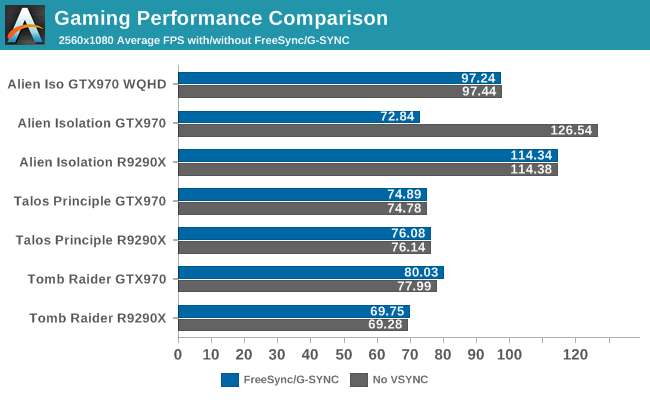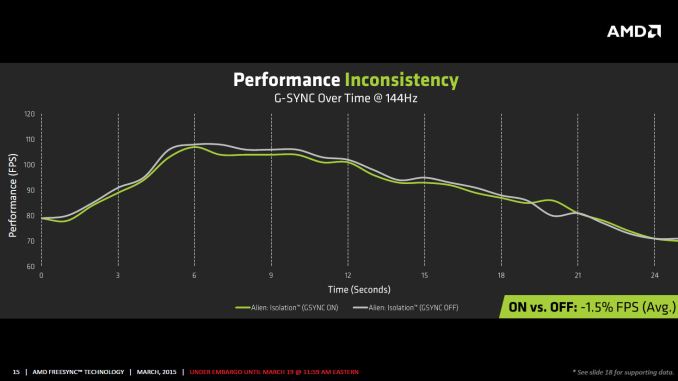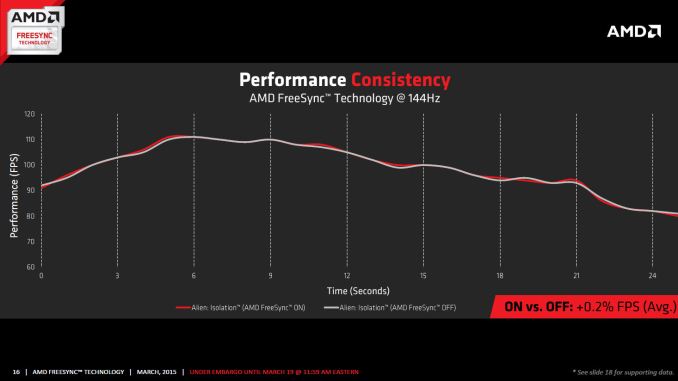The AMD FreeSync Review
by Jarred Walton on March 19, 2015 12:00 PM ESTFreeSync vs. G-SYNC Performance
One item that piqued our interest during AMD’s presentation was a claim that there’s a performance hit with G-SYNC but none with FreeSync. NVIDIA has said as much in the past, though they also noted at the time that they were "working on eliminating the polling entirely" so things may have changed, but even so the difference was generally quite small – less than 3%, or basically not something you would notice without capturing frame rates. AMD did some testing however and presented the following two slides:
It’s probably safe to say that AMD is splitting hairs when they show a 1.5% performance drop in one specific scenario compared to a 0.2% performance gain, but we wanted to see if we could corroborate their findings. Having tested plenty of games, we already know that most games – even those with built-in benchmarks that tend to be very consistent – will have minor differences between benchmark runs. So we picked three games with deterministic benchmarks and ran with and without G-SYNC/FreeSync three times. The games we selected are Alien Isolation, The Talos Principle, and Tomb Raider. Here are the average and minimum frame rates from three runs:


Except for a glitch with testing Alien Isolation using a custom resolution, our results basically don’t show much of a difference between enabling/disabling G-SYNC/FreeSync – and that’s what we want to see. While NVIDIA showed a performance drop with Alien Isolation using G-SYNC, we weren’t able to reproduce that in our testing; in fact, we even showed a measurable 2.5% performance increase with G-SYNC and Tomb Raider. But again let’s be clear: 2.5% is not something you’ll notice in practice. FreeSync meanwhile shows results that are well within the margin of error.
What about that custom resolution problem on G-SYNC? We used the ASUS ROG Swift with the GTX 970, and we thought it might be useful to run the same resolution as the LG 34UM67 (2560x1080). Unfortunately, that didn’t work so well with Alien Isolation – the frame rates plummeted with G-SYNC enabled for some reason. Tomb Raider had a similar issue at first, but when we created additional custom resolutions with multiple refresh rates (60/85/100/120/144 Hz) the problem went away; we couldn't ever get Alien Isolation to run well with G-SYNC using our custome resolution, however. We’ve notified NVIDIA of the glitch, but note that when we tested Alien Isolation at the native WQHD setting the performance was virtually identical so this only seems to affect performance with custom resolutions and it is also game specific.
For those interested in a more detailed graph of the frame rates of the three runs (six total per game and setting, three with and three without G-SYNC/FreeSync), we’ve created a gallery of the frame rates over time. There’s so much overlap that mostly the top line is visible, but that just proves the point: there’s little difference other than the usual minor variations between benchmark runs. And in one of the games, Tomb Raider, even using the same settings shows a fair amount of variation between runs, though the average FPS is pretty consistent.


















350 Comments
View All Comments
Hrel - Thursday, March 19, 2015 - link
I'm so sick of this proprietary shit, when companies want to do something new why not work with the other companies in the industry to come up with the best solution for the problem and make it universal? Customers NEVER jump onto a technology that only works from one company, we aren't going to commit to a monopoly. I get that they want a competitive edge in the market, but it literally never works that way. What happens is they spend all this money on R&D, marketing, prototyping, waste everyone's time with marketing and reviews only to have a handful of people pick it up (probably too few to even break even) and then it stops growing right there until a universal standard comes out that the industry adapts as a whole.Just fucking stop wasting everyone's time and money and choose cooperation from the start!
HunterKlynn - Thursday, March 19, 2015 - link
For the record, AMDs solution here *is* an attempt at an open standard. GSync is the proprietary one.dragonsqrrl - Thursday, March 19, 2015 - link
...Black Obsidian - Thursday, March 19, 2015 - link
It's hard to be more open than being an official (albeit optional) part of the DisplayPort spec itself.DominionSeraph - Thursday, March 19, 2015 - link
I'm sure AMD will be happy to give you the masks to the 290X and 390X, if you only ask. "I'm sick of there only being two players in the market. Why don't you let me in? I'm sure I could sell your products for less than your prices!"lordken - Thursday, March 19, 2015 - link
next time when you try to make someone look stupid, try no to look like fool by yourself. Another dogma believer that thinks without patents world will end. Same as copyright believers that music&entertainment without copyright will stop to exist...If you think about it, you can see that patents can actually pretty much slow down technology advancement. You can even see that today with Intel CPUs, as AMD cannot catch up and CPUs are patent locked we are left to be milked by Intel with minimal performance gains between generations. If either AMD would have better CPUs or could simply copy good parts from Intel and put into their design today, imho, we would be much far with performance. Also look around you and see that 3D printing boom? Guess what few years back and last year patents expired and allowed this. Yes 3D printing was invented 30years ago, yet it gets to your desk only today. So much for patent believers.
btw even if AMD would give you their blueprints what would you do? Start selling R390X tomorrow right? Manufactured out of thin air. By the time you could sell R390X we would be at 590 generation. Possibly only nvidia/intel would be able to benefit that sooner (which isnt necesarily a bad thing)
lordken - Thursday, March 19, 2015 - link
@Hrel: a) cause most corporations are run by greedy bastards imho b) today managers of said corporations cant employ common sense and are disconnected from reality making stupid/bad decisions. I see it in big corporation i work for...so using brain and "pro-consumer" way of thinking is forbidden.
Flunk - Thursday, March 19, 2015 - link
Please just support the Adaptive VSync standard Nvidia, your G-Sync implmentation doesn't have any benefits over it. You don't need to call it FreeSync, but we all need to settle on one standard because if I have to be locked in to one brand of GPU based on my monitor isn't not going to be the one that's not using industry standards.Murloc - Thursday, March 19, 2015 - link
a monitor lasts much longer than a GPU and costs more too for most users out there so yeah, standards win.They can call it adaptive sync as that's what it is. A Displayport standard.
praeses - Thursday, March 19, 2015 - link
It would be interesting to see input lag comparisons and videos of panning scenes in games that would typically cause tearing captured at higher speed played in slow motion.